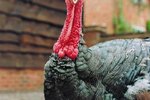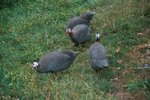
If you only think of a goose as the guest of honor on your Christmas dinner table, think again. As many people have discovered, a goose can make a great pet. This larger relative of the duck is intelligent, outgoing and easy to care for, and it typically enjoys human companionship. It is also protective of its territory -- and loud. So if you’re looking for a non-canine watchdog, a goose might be a good choice.
History
Geese adapt well to captivity and were likely among some of the first wild animals to be domesticated by humans. Archeologists have found evidence that ancient Egyptians kept domestic geese 3,000 years ago. They were an important source of food and fat throughout Europe during the Middle Ages. European colonists brought domestic geese to America, where they were very popular with farmers for their meat, eggs, feathers and down. These days, commercial goose farming has been far out shadowed by chicken and turkey farming, and geese are seen primarily as barnyard livestock or pets.
Gifts from Geese
Geese as pets are more than just barnyard waterfowl wandering around the farm or semi-urban backyards where allowed. If you raise them from a very young age, they will form a strong bond with you and follow you around like a puppy. Females will supply you with eggs that you can use as you would those of other poultry. They have become popular weed eaters on organic farms, as well as prolific fertilizer providers. They have excellent eyesight and will honk loudly to alert you to visitors, intruders or predators. Some herding dog trainers will even use them in lieu of sheep or cattle to help train their dogs.
Caring for Geese
Geese are fairly easy to care for. However, they are large birds, which means they're harder to handle, eat more and produce more droppings than chickens and ducks. If you get them as goslings, you need to be prepared to take care of them for 15 to 20 years. You’ll need a large fenced in area to keep them from wandering off and predators out. Provide a place for them to get out of the sun. Most geese prefer to stay outside, but if you live in areas where winters are very cold, you should provide adequate shelter. If you don’t have a poultry barn, a small shed or large dog house lined with straw will work.
Geese love grass and other small greens, but you need to also provide a commercial waterfowl food. Your local feed store will assist you in providing the right food for each stage of their lives. They also require grit to digest their food and a constant source of water. To protect them from various avian diseases, make sure their food and bedding are not moldy and their water is not stagnant.
Breeding Geese
If you plan to raise goslings, you’ll of course need a male goose, or gander. Goose pairs often form life-long bonds and have strong parenting skills. During spring nesting season, the female will build a nest and lay up to 15 eggs. She incubates the eggs for 28 to 30 days while the gander stands guard. Alternatively, you can remove the eggs and incubate them yourself.
References
Photo Credits
-
Digital Vision./Digital Vision/Getty Images




